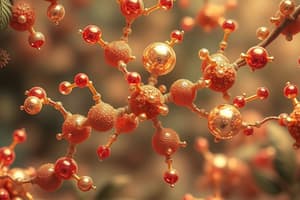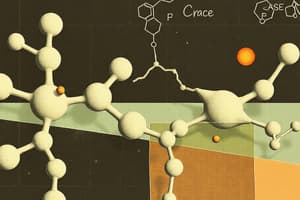Podcast
Questions and Answers
Why are biological macromolecules important for everyday life?
Why are biological macromolecules important for everyday life?
They provide energy and structure to living organisms and their cells.
What is the structure and function of carbohydrates?
What is the structure and function of carbohydrates?
Structure: Carbon, hydrogen, and oxygen. Function: Stores glucose as an energy reserve, sometimes provides structural support for cells.
What is the structure and function of lipids?
What is the structure and function of lipids?
Structure: Glycerol attached to a phosphate group and two fatty acids. Function: To store energy, signal, and act as structural components of cell membranes.
What is the structure and function of proteins?
What is the structure and function of proteins?
What is the structure and function of nucleic acids?
What is the structure and function of nucleic acids?
Describe how enzymes regulate chemical reactions.
Describe how enzymes regulate chemical reactions.
Explain how molecular diversity is based on the properties of carbon.
Explain how molecular diversity is based on the properties of carbon.
Describe the developments that led to the cell theory.
Describe the developments that led to the cell theory.
Describe the structure of the cell membrane.
Describe the structure of the cell membrane.
Distinguish between active and passive transport.
Distinguish between active and passive transport.
Differentiate between eukaryotic and prokaryotic cells.
Differentiate between eukaryotic and prokaryotic cells.
Describe the theory of the origin of eukaryotic cells (endosymbiosis).
Describe the theory of the origin of eukaryotic cells (endosymbiosis).
What evidence supports the theory of endosymbiosis?
What evidence supports the theory of endosymbiosis?
Describe the internal structures of eukaryotic cells.
Describe the internal structures of eukaryotic cells.
Summarize the functions of the organelles found in plant and animal cells.
Summarize the functions of the organelles found in plant and animal cells.
Relate structure to function of plant and animal cells.
Relate structure to function of plant and animal cells.
What is the importance of ATP as an energy-carrying molecule in cells?
What is the importance of ATP as an energy-carrying molecule in cells?
Identify the energy sources used by organisms.
Identify the energy sources used by organisms.
Flashcards are hidden until you start studying
Study Notes
Biological Macromolecules
- Biological macromolecules provide energy and structural integrity to living organisms and their cells.
Carbohydrates
- Composed of carbon, hydrogen, and oxygen.
- Store glucose as an energy reserve and can provide structural support for cells.
Lipids
- Structure includes glycerol linked to a phosphate group and two fatty acids.
- Function to store energy, send signals, and form structural components of cell membranes.
Proteins
- Comprised of 50 amino acids linked together.
- Serve multiple functions: structure, transport, storage, signaling, movement, and immune defense.
Nucleic Acids
- Built from nucleotides.
- Carry genetic information essential for building and maintaining organisms.
Enzymes
- Catalyze chemical reactions by lowering the activation energy required, thereby increasing reaction rates.
Molecular Diversity and Carbon
- Life's complexity stems from carbon's ability to form diverse structures with four potential covalent bonds, enabling large macromolecule formation.
Cell Theory Development
- Resulted from advancements in microscopy, observations of cells, and the understanding that cells are the fundamental unit of life and cannot arise spontaneously.
Cell Membrane Structure
- Composed of carbohydrates, phospholipids, and proteins, organized in a phospholipid bilayer with hydrophilic ends oriented outward.
Active vs. Passive Transport
- Passive transport requires no energy, allowing materials to move across cell membranes naturally, whereas active transport requires cellular energy.
Eukaryotic vs. Prokaryotic Cells
- Prokaryotes lack a defined nucleus and complex structures, while eukaryotes possess organelles and are generally larger and more complex.
Endosymbiotic Theory
- Suggests modern eukaryotic cells originated from a symbiotic relationship between multiple prokaryotic cells.
Evidence for Endosymbiosis
- Mitochondria and chloroplasts in eukaryotic cells can reproduce independently and possess their own circular DNA and ribosomes.
Internal Structures of Eukaryotic Cells
- Include plasma membrane, cytoplasm, ribosomes, nucleus, and a variety of membrane-bound organelles.
Functions of Organelles
- Plant and animal cells share organelles like the nucleus and mitochondria, performing diverse functions from nutrient intake to energy conversion.
Structure and Function of Plant vs. Animal Cells
- Plant cells focus on storage, while animal cells provide bodily structure, nutrient conversion, and specialized functions.
Importance of ATP
- ATP acts as an immediate energy source for cellular functions, powering various biological processes.
Energy Sources for Organisms
- Organisms derive energy from fats, carbohydrates, and proteins during digestion, utilizing the released energy for metabolic activities.
Studying That Suits You
Use AI to generate personalized quizzes and flashcards to suit your learning preferences.




